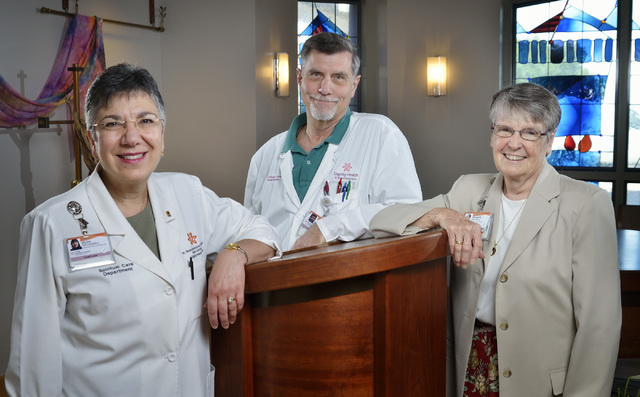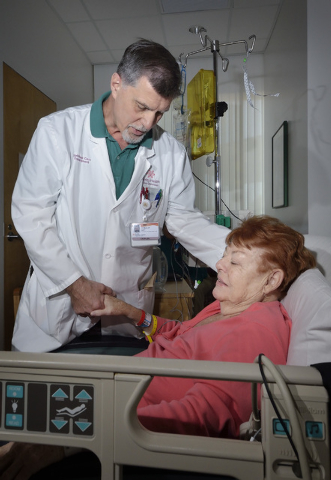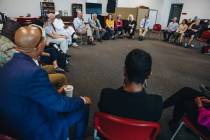St. Rose chaplains stress spiritual aspects of care
So you walk into a hospital room and try to convert everyone to Catholicism, right?
An emphatic “no,” says chaplain Hilda Pecoraro, a full-time staff member at Dignity Health — St. Rose Dominican Hospitals Siena Campus. “St. Rose Siena is a faith-based hospital, yes, but when a patient is having a hard time, our role is simply to help the patient identify his or her own spiritual resources, whether those be in traditional religion, family members, friends, pets … whatever gives meaning and purpose in their lives.”
Pecoraro isn’t even Catholic; she is Presbyterian, and in a conversation including colleague Ron May, a Catholic, and Sister Kathleen (Katie) McGrail, vice president of mission integration and spiritual care for the Siena campus, the point was made that chaplains are people of faith, but any faith background is welcomed, along with the proper certification.
McGrail notes that among the professionals at the valley’s three St. Rose Dominican Hospitals are Methodist, Baptist, Episcopalian, Presbyterian, nondenominational Christian and Catholic chaplains.
“Faith-based hospitals such as St. Rose believe healing involves body, mind and spirit,” McGrail says, “and chaplains are a critical ingredient to our mission. We have three full-time staff chaplains serving the Siena campus and three part-time chaplains.” (Chaplain Ron Solomine is the third full-time member of the Siena campus team.) A priest chaplain on staff, who rotates across the three campuses, provides visits and sacramental ministry to the Catholic patients. Each of the Siena Campus full-time chaplains are on call one night every two weeks. The other evenings are served by the part-timers.
“Sometimes our job is simply to listen when people — patients, family members or even staff — need to talk,” Pecoraro says.
“If it’s appropriate, we do pray with patients,” adds May. He explains that quite often his own faith is renewed by meeting some of the courageous and inspiring patients in the hospital. “Blessings go both ways,” he says.
“Ninety-eight percent of the people we meet are gracious, loving and caring,” adds Pecoraro. “Often being in a vulnerable position brings out the best in people.”
Not all people who are scared and in a strange hospital environment want to see a chaplain. “Hospital doors have no locks,” Pecoraro says, “but we don’t barge in. We wear white coats, but we knock, introduce ourselves and ask if this is a good time for a visit. Sometimes, I feel like a car salesman with nobody interested in buying. Other times, I know I am making a difference in a patient’s life.”
To become a board-certified chaplain, an individual typically has a master’s degree in theology or divinity, plus the equivalent of a year of clinical pastoral training on the job.
Several organizations, such as the Association of Professional Chaplains, provide professional chaplain certification. May made the training and certification commitment following years in the mental-health field. Pecoraro was a pastor at Green Valley Presbyterian Church before deciding to become a professional chaplain.
“Doctors and nurses love us,” May says. “They take care of the patient’s medical needs and are often quite busy; we can take the time to tend to emotional and spiritual comforting.”
“We may be called to be with a family of a dying patient; we may be called simply because a patient is stressed having to wait too long in the emergency room,” Pecoraro says.
“Although a chaplain isn’t trying to convert nonbelievers,” McGrail says, “it is true that in a time of sickness, many people start to look into the religious aspect of their lives.
“The chaplains will always call any other people of faith that the patient may want to see. We have a couple of LDS staff members who have said they are also available if needed by LDS patients.”
Another duty taken on by the St. Rose chaplains is to assist patients who wish to make or change advance directives. Special services in the chapel are held, once a quarter, for families of people who have died at the hospital; chaplains conduct the services. Should a patient be comforted by the warmth of a prayer shawl and a prayer, that, too, can be provided.
Is the work of a chaplain sad?
“Yes, sometimes,” says Pecoraro, whose assignment at the Siena campus includes the maternity and neonatal floors. “There have been days when I said I never want to see another sick person, but that passes quickly,” she explains. “When a young child is ill or passes away, that is heart-wrenching, but I realize I personally can’t change the medical situation, so I focus on what I can do. I can help staff members cope with their own sadness by what we call ‘debriefing.’ I can, without flinching, bear witness to the lives of the child or the family. I also know it’s my own faith in God that allows me to do this work.”
Would the life of a professional chaplain be recommended to others? May says he has made such recommendations to two people he thought had the “right stuff.” One has become a chaplain.
When asked what the right stuff entails, May talks about the importance of listening, the willingness to accompany people on their journey during a difficult time and “the ability to put any prejudices aside and at the appropriate time examine the reasons behind those feelings.”
Pecoraro notes that an effective chaplain also continues to explore his or her own life and faith.
Chaplains must complete 50 hours a year of continuing education in subjects such as grief support or anticipated changes in the country’s health care system.
“And if you’re not OK with yourself and God, you will not be good at this job. ”























